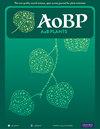低地热带雨林树木生长过程中木质特征与物种分布之间的联系变化
IF 2.4
3区 生物学
Q2 ECOLOGY
引用次数: 0
摘要
基于性状的生态学的一个基本假设是,性状可以预测物种的人口分布。然而,一般来说,性状与繁殖率之间的联系并没有预期的那么紧密。这些微弱的联系可能是由于使用了与表现关系密切的性状,和/或没有考虑到性状和人口统计率中与大小相关的变化。在此,我们研究了亚马孙东部低地森林中19种树木的木材性状与繁殖率的关系。我们测量了树苗、幼树和成树木材的 11 种木材性状(即结构、解剖和化学性状),并将它们与不同发育阶段的生长率和死亡率联系起来。在树木生长过程中,木材性状与死亡率之间的联系发生了变化。在树苗阶段,相对生长率(RGR)与木材比重(WSG)和总的实质部分呈负相关,而死亡率(MR)随径向实质部分的减少而减少,但随血管腔面积(VA)的增加而增加。幼年的 RGR 与木材性状无关,而幼年的 MR 与 WSG 和轴向实质部分呈负相关。在成体阶段,RGR与VA和木材钾浓度成比例。任何性状都不能预测成体的MR。总体而言,性状与密度之间的关联强度在发育后期有所降低。我们的研究结果表明,随着树木年龄的增长,性状与人口统计率之间的关系会发生变化。此外,木材化学或解剖学性状可能比WSG更能预测生长率和死亡率。我们的研究结果拓宽了我们对树木发育过程中木材性状与人口统计学之间联系的认识,对扩展我们对热带森林中树木生命史变异和群落动态的了解非常重要。本文章由计算机程序翻译,如有差异,请以英文原文为准。
The links between wood traits and species demography change during tree development in a lowland tropical rainforest
One foundational assumption of trait-based ecology is that traits can predict species demography. However, the links between traits and demographic rates are, in general, not as strong as expected. These weak associations may be due to the use of traits that are distantly related to performance, and/or the lack of consideration of size-related variations in both traits and demographic rates. Here, we examined how wood traits were related to demographic rates in 19 tree species from a lowland forest in eastern Amazonia. We measured eleven wood traits (i.e., structural, anatomical and chemical traits) in sapling, juvenile and adult wood; and related them to growth and mortality rates at different ontogenetic stages. The links between wood traits and demographic rates changed during tree development. At the sapling stage, relative growth rates (RGR) were negatively related to wood specific gravity (WSG) and total parenchyma fractions, while mortality rates (MR) decreased with radial parenchyma fractions, but increased with vessel lumen area (VA). Juvenile RGR were unrelated to wood traits, whereas juvenile MR were negatively related to WSG and axial parenchyma fractions. At the adult stage, RGR scaled with VA and wood potassium concentrations. Adult MR were not predicted by any trait. Overall, the strength of the trait-demography associations decreased at later ontogenetic stages. Our results indicate that the associations between traits and demographic rates can change as trees age. Also, wood chemical or anatomical traits may be better predictors of growth and mortality rates than WSG. Our findings are important to expand our knowledge on tree life-history variations and community dynamics in tropical forests, by broadening our understanding on the links between wood traits and demography during tree development.
求助全文
通过发布文献求助,成功后即可免费获取论文全文。
去求助
来源期刊

AoB Plants
PLANT SCIENCES-
CiteScore
4.80
自引率
0.00%
发文量
54
审稿时长
20 weeks
期刊介绍:
AoB PLANTS is an open-access, online journal that has been publishing peer-reviewed articles since 2010, with an emphasis on all aspects of environmental and evolutionary plant biology. Published by Oxford University Press, this journal is dedicated to rapid publication of research articles, reviews, commentaries and short communications. The taxonomic scope of the journal spans the full gamut of vascular and non-vascular plants, as well as other taxa that impact these organisms. AoB PLANTS provides a fast-track pathway for publishing high-quality research in an open-access environment, where papers are available online to anyone, anywhere free of charge.
 求助内容:
求助内容: 应助结果提醒方式:
应助结果提醒方式:


